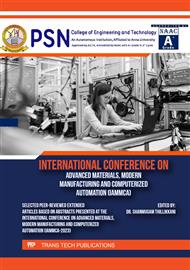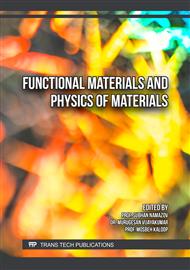[1]
Yin B, Liu G, Zhou H, Chen J and Yan F 2010 Sliding wear behaviour of HVOF-sprayed Cr3C2–NiCr/CeO2 composite coatings at elevated temperature up to 800°C Tribol. Lett., 37 463-475.
DOI: 10.1007/s11249-009-9540-5
Google Scholar
[2]
C.K. Lin, C.C. Berndt, Proceedings of the 1993 National Thermal Spray Conference, Anaheim, CA, 7–11 June 1993, p.561.
Google Scholar
[3]
Bala, N., Singh, H. and Prakash, S., 2009. High-temperature oxidation studies of cold-sprayed Ni–20Cr and Ni–50Cr coatings on SAE 213-T22 boiler steel. Applied Surface Science, 255(15), pp.6862-6869.
DOI: 10.1016/j.apsusc.2009.03.006
Google Scholar
[4]
Seong B G, Hwang S Y, and Kim K Y, Surf Coat Technol 126 (2000) 256.
Google Scholar
[5]
J. Cabral Miramontes, G.K. Pedraza Basulto, C. GaonaTiburcio, P.D.C. Zambrano Robledo, C.A. Poblano Salas, and F. AlmerayaCaldero´n, Coatings Characterization of Ni-Based Alloy Applied by HVOF, Aircr. Eng. Aerosp. Technol., 2018, 90(2), pp.336-343
DOI: 10.1108/aeat-09-2016-0146
Google Scholar
[6]
P. Sahoo, R. Raghuraman, in: C.C. Berndt, T.F. Bernecki (Eds.), Thermal Spray Coatings: Research, Design and Applications, ASM International, Materials Park, Ohio, USA, 1993, p.405.
Google Scholar
[7]
C.-J. Li, Y.-Y. Wang, G.-J. Yang, A. Ohmori, K.A. Khor, Mater. Sci. Technol. 20 (2004) 1087.
Google Scholar
[8]
D.C. Crawmer, J.D. Krebsbach, W.L. Riggs, in: C.C. Berndt (Ed.), Proceedings of the International Thermal Spray Conference and Exposition, ASM International, Materials Park, Ohio, 1992, p.127
Google Scholar
[9]
C.J. Li, G.C.Ji, Y.Y. Wang, K. Sonoya, The dominant mechanism of carbon loss during HVOF spraying of Cr3C2-NiCr, Thin Solid Films 419 (2002) 137–143
DOI: 10.1016/s0040-6090(02)00708-3
Google Scholar
[10]
J. Rapouch, Degradation of Cr3C2-NiCr coating prepared by the HVOF technique, Kovove Mater.57 (2013)82–86
DOI: 10.2478/kom-2013-0009
Google Scholar
[11]
Handbook, A.S.M., 1992. Alloy phase diagrams, vol 03. ASM International, Materials Park, p.556 and 1107
Google Scholar
[12]
Hillery, R.V., 1986. Coatings for performance retention. Journal of Vacuum Science & Technology A: Vacuum, Surfaces, and Films, 4(6), pp.2624-2628
DOI: 10.1116/1.573693
Google Scholar



